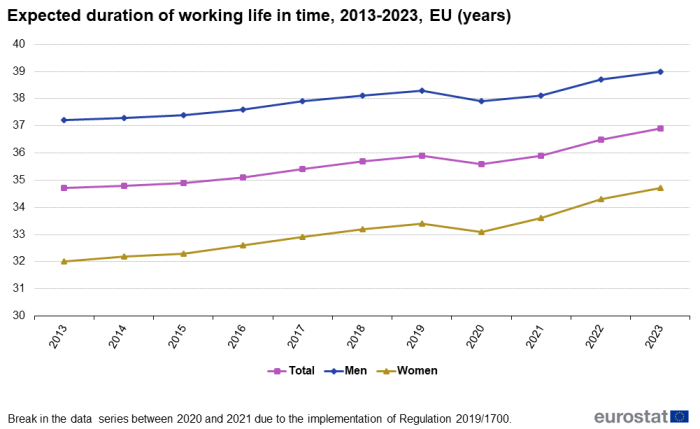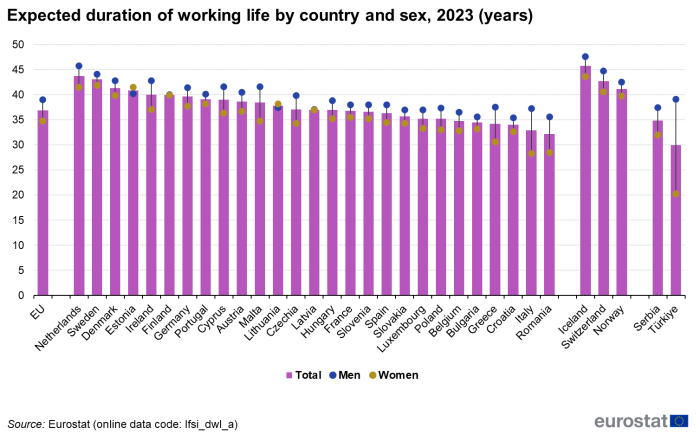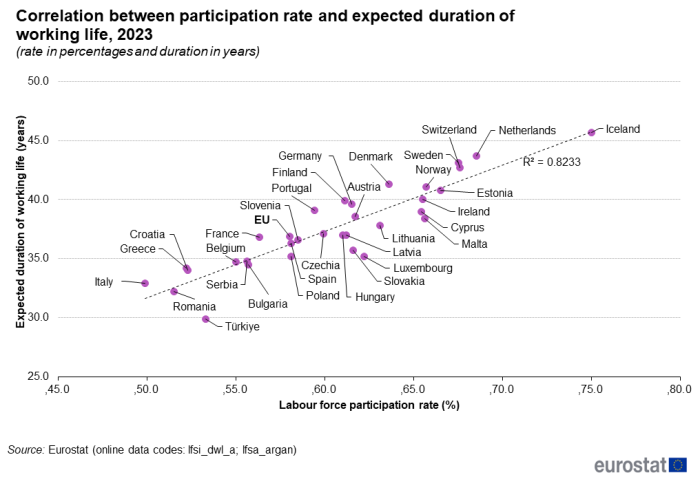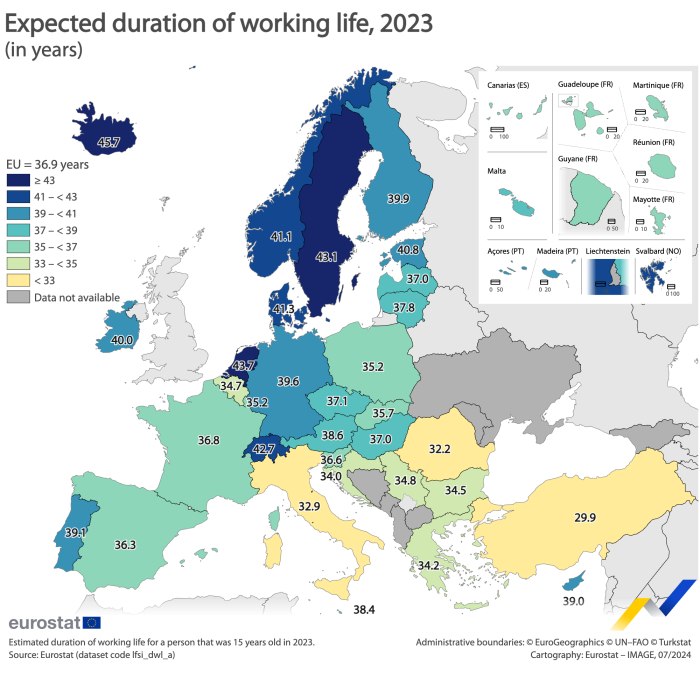Duration of working life - statistics
Data extracted in June 2024
Planned article update: July 2025
Highlights
The indicator on duration of working life is an estimation of the number of years a person, currently aged 15 years, is expected to be in the labour force (i.e. to be employed or unemployed) throughout his or her life. It aims to provide a different point of view on the labour market, looking at the entire life cycle of persons in the labour force rather than on specific states in the life cycle, such as youth unemployment or early withdrawal from the labour force.
In this article, the expected duration of working life is described for the European Union (EU) as a whole, for the 27 EU countries individually, for three EFTA countries (Iceland, Norway and Switzerland) and two candidate countries (Serbia and Türkiye).
Full article
Steady increase in the expected duration of working life in the EU
The expected duration of working life was on average 36.9 years in the EU in 2023, 39.0 years for men and 34.7 years for women (see Figure 1). Since 2013, the expected duration of working life steadily increased in the EU from 34.7 years in 2013 to 35.9 years in 2019. In 2020, linked to the COVID-19 health crisis, the expected duration of working life decreased to 35.6 years.
Despite the halt in 2020, the indicator has witnessed a constant growth in the years of working life over the past 10 years for both sexes. Although men are expected to work longer than women, the gender gap has reduced with increasing female participation in the labour market. Indeed, the estimated expected duration of working life for men was 37.2 years in 2013, while for women it was 32.0 years. Compared with 2013, the gender gap of the expected duration of working life was consequently narrower in 2023 (4.3 years compared with 5.2 years).

Source: Eurostat (lfsi_dwl_a)
North European countries have the longest working life
In the EU, the expected duration of working life has varied broadly according to countries and their geographical location. The Netherlands was the country recording the longest duration of working life, 43.7 years. Countries in north Europe follow, all with durations exceeding 40 years, Sweden (43.1 years), Denmark (41.3 years) and Estonia (40.8 years) ranked highest. The shortest durations of working life, less than 35 years, were recorded in Romania (32.2 years) and in several south European countries, namely Italy (32.9 years), Croatia (34.0 years), Greece (34.2 years)and Bulgaria (34.5 years), followed by Belgium (34.7 years) (see Map 1).
Gender gap in 2023
In 2023, differences in the average number of years of working life between men and women were observed in all countries. In general men are expected to work longer than women, with north European countries showing a gender gap below the EU average of 4.3 years. Lithuania and Estonia were the only EU countries where the gender gap was negative, as women are expected to work 1.3 years and 0.8 years more than men, respectively. Among the other countries, the smallest gender gap was recorded in Latvia and in Finland with only 0.1 years. On the opposite, the countries with the greatest gender gap in 2023, were Italy (8.9 years), Romania (7.1 years), Greece and Malta (both 6.9 years).
Comparing the EU countries, men are expected to work the longest in the Netherlands (45.7 years), Sweden (44.1 years), Denmark (42.8 years), Ireland (42.8 years), Cyprus (41.6 years), Malta (41.6 years) and Germany (41.4 years) (see Figure 2). On the opposite side, the countries where men are expected to work the least, are Croatia with 35.4 years, Bulgaria (35.6 years), Romania (35.6 years) and Belgium (36.5 years).
Concurrently, the EU countries where women are expected to work less than 30 years in their lifespan are Italy (28.3 years) and Romania (28.5 years). Followed by Greece (30.6 years), Croatia (32.6 years), Belgium (32.8 years), Poland (33.0 years), Bulgaria (33.2 years) and Luxembourg (33.3 years), all with less than 34 years.
By contrast, the longest durations of working life for women, i.e. more than 38 years, were found in Sweden (41.9 years), the Netherlands (41.5 years), Estonia (41.5 years), Finland (39.9 years), Denmark (39.8 years), Lithuania and Portugal (both 38.2 years).

Source: Eurostat (lfsi_dwl_a)
Different trends among countries
Between 2013 and 2023, the expected duration of working life increased in all EU countries except Romania (see Figure 3). Notably, five countries experienced a significant increase of four or more years: Hungary (6.2 years), Malta (5.3 years), Ireland (4.4 years), Estonia (4.3 years) and the Netherlands (4.0 years). Hungary and Malta, which had below average expected duration of working life in 2013, had surpassed the EU average in 2023 due to their sharp increases. Main reason of Malta's exceptional growth was the remarkable increase in expected working life among women (8.9 years), the largest gain in any EU country.
In contrast, Spain, Germany, and Austria experienced relatively stable expected duration of working life, with increases of less than two years. Romania was the only country to experience a decline (0.4 years), primarily due to a decrease among women.
A notable trend in most EU countries was that women's duration of working life increased more than men, with the only exceptions being Denmark and Romania. In Malta, Slovakia, Luxembourg, Estonia, and Cyprus, the increase was significantly higher for women than men. In Bulgaria, Slovenia, Denmark, and Sweden, the increases for men and women were roughly equal.

Source: Eurostat (lfsi_dwl_a)
Source data for tables and graphs
Methods and definitions
The duration of working life is calculated using the labour force participation rates (previously called "activity rates") from the Labour Force Survey and life tables from demography statistics. Both the participation rates (in 5 year bands) and the complete life tables (per single year) are published by Eurostat.
Data sources
Source: The European Union Labour Force Survey (EU-LFS) is the largest European household sample survey providing quarterly and annual results on labour participation of people aged 15 years and over as well as on persons outside the labour force. It covers residents in private households. Conscripts in military or compulsory community service are not included in the results. The EU-LFS is based on the same target populations, and uses the same definitions, in all countries, which means that the results are comparable among the countries. The EU-LFS is an important source of information about situations and trends in the national and EU labour markets. Each quarter around 1.2 million interviews are conducted throughout the participating countries to obtain statistical information for some 100 variables. Due to the variety of information and the large sample size, the EU-LFS is also an important source for other European statistics like Education statistics or Regional statistics.
Reference period: Yearly results are obtained as averages of the four quarters in the year.
Coverage: The results from the survey currently cover all European Union countries, the EFTA countries Iceland, Norway and Switzerland, as well as the candidate countries Montenegro, North Macedonia, Serbia and Türkiye. For Cyprus, the survey covers only the areas of Cyprus controlled by the Government of the Republic of Cyprus.
European aggregates: EU refers to the totality of the EU of 27 countries. If data are unavailable for a country, the calculation of the corresponding aggregates takes into account the data for the same country for the most recent period available. Such cases are indicated.
Country notes
In Germany, from the first quarter of 2020 onwards, the Labour Force Survey (LFS) is part of a new system of integrated household surveys. Technical issues and the COVID-19 crisis has had a great impact on data collection processes in 2020, resulting in low response rates and a possibly biased sample. For more information, see here.
In the Netherlands, since 2021 LFS data is collected by using a rolling reference week instead of a fixed reference week, i.e. interviewed persons are asked about the situation of the week before the interview rather than a pre-selected week.
Definitions
The concepts and definitions used in the EU-LFS follow the resolutions of the International Conference of Labour Statisticians (the ICLS, organised by the International Labour Organisation, the ILO). In particular, employed people comprise: (a) persons who during the reference week worked for at least one hour for pay or profit or family gain; (b) persons who were not at work during the reference week but had a job or business from which they were temporarily absent.
The LFS employment concept differs from national accounts domestic employment, as the latter sets no limit on type of household, includes the non-resident population contributing to national GDP and excludes resident population contributing to the GDP of a different country.
Time series
Regulation (EU) 2019/1700 came into force on 1 January 2021 and possibly induced a break in the LFS time series for several EU countries. In order to monitor the evolution of employment and unemployment despite of the break in the time series, EU countries assessed the impact of the break in their country and computed impact factors or break corrected data for a set of indicators. Break corrected data are published for the LFS main indicators.
More information
More information on the LFS can be found via the online publication EU Labour Force Survey, which includes eight articles on the technical and methodological aspects of the survey. The EU-LFS methodology in force from the 2021 data collection onwards is described in methodology from 2021 onwards. Detailed information on coding lists, explanatory notes and classifications used over time can be found under documentation.
Context
The expected duration of working life indicator was developed at the request of the Employment Committee indicators group under the EU 2020 strategy. It uses life expectancy tables and participation rates as input for the calculation. The methodology was developed at the Ministry of Labour of Finland, in a Monitoring the employment strategy and the duration of active working life by Helka Hytti and Ilkka Nio.
A common misunderstanding in the public debate on this indicator is that it shows how long persons must or should work. This is not the case. The indicator is purely descriptive and shows what is happening, not what should happen.
As it is an average computed over all adults in the country, the indicator is heavily influenced by the number of persons outside the labour force in a country. In other words, it does not make any claims about how many years the persons who are in employment, work. It rather shows the combined effect of:
- what proportion of the adult population is in the labour force (being employed or unemployed) in each year of their life,
- and the life expectancy.
Most of the duration of working life can be explained by the labour force participation rate. An illustration for the total population, comparing the expected duration working life with the labour force participation rate in each country, is presented in Figure 4. Based on the given linear regression model, the labour force participation rate explains around 82% of the variance in the expected duration of working life suggesting a fairly good fit, as indicated by the coefficient of determination (R2) in Figure 4.

Source: Eurostat (lfsi_dwl_a) and (lfsa_argan)
Direct access to
- Duration of working life - annual data (lfsi_dwl_a)
Publications
- Labour force survey in the EU, EFTA and candidate countries — Main characteristics of national surveys, 2021, 2024 edition
- Quality report of the European Union Labour Force Survey 2020, 2022 edition
- EU labour force survey — online publication
ESMS metadata files and EU-LFS methodology
- Employment and unemployment (Labour Force Survey) (ESMS metadata file — employ_esms)
- LFS main indicators (ESMS metadata file — lfsi_esms)
- LFS series - detailed annual survey results (ESMS metadata file — lfsa_esms)
